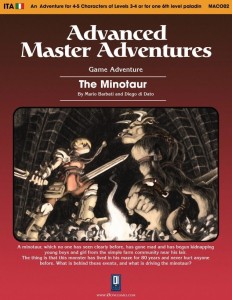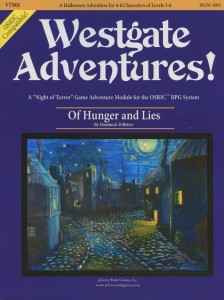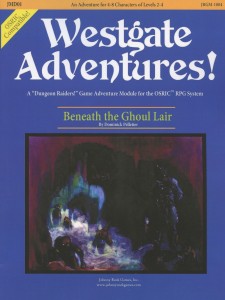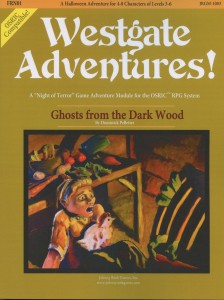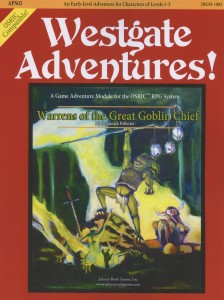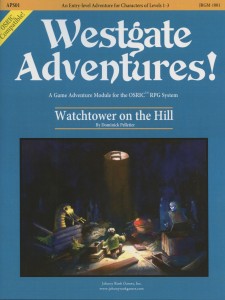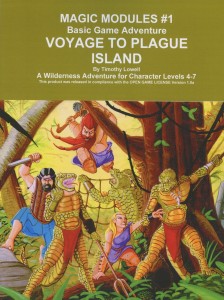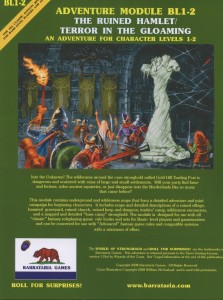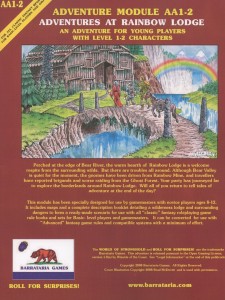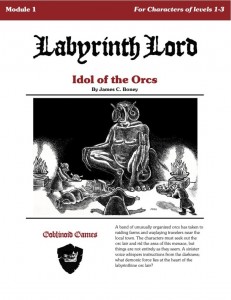A minotaur, which no one has seen clearly before, has gone mad and has begun kidnapping young boys and girl from the simple farm community near his lair. The thing is that this monster has lived in his maze for 80 years and never hurt anyone before. What is behind these events, and what is driving the minotaur?
This is a light adventure module that’s sparse on combat and has an ethical dilemma in the end. It’s meant for four 3rd levels characters or one 6th level Paladin.
This module fits in to two interesting sub-niches: 1-on-1 play and Solo Monsters. I like solo and 1-on-1 modules as a nice replacement for a 2-player board game. The wife and I played Grave of the Green Flame over and over again with Holmes-edition characters and I received a nice collection of 1-on-1 adventures in the RPGgeek Secret Chthanta program that we’re looking forward to breaking in to soon. Likewise, 100 Bushels of Rye may be one of the best modules ever produced, and centers around a small village with some issues and single monster in his lair. I think these solo monster products build up a lot of tension; the players explore and talk to villagers which provide a lot of roleplaying and foreshadowing, and then venture in to the monsters lair to confront the beast. You know Smaugs there. You know he’s powerful and can kick your ass 12 ways to Sunday, and yet you go anyway …
The module was written as a 1-on-1 for a single 6th level Paladin, who is included as a pregen. Each section has some notes on how to convert it to group play however it’s almost always unnecessary; the bulk of the changes are just rewording the boxed and removing some references to this being the Paladins home village. There’s about two pages of introductory prep that includes backstory, synopsis, hooks, and so on. None of them are particularly strong, and it’s quite wordy, however the kick-off is a pretty good one: a farmers young son has just been chose by lot to be a sacrifice to the minotaur and the farmer is vigorously protesting. The other farmers are advancing. What do you do?
That’s a good kick off with some strong opportunity for role-play. There are a couple of other things the party can do in the village: talk to the elder, visit the wise-woman, and talk to the villagers. Eventually they will end up at a cave entrance on a hill where everyone knows the minotaur lives. This is the start of short little 26 room dungeon. The dungeon map is not the complex looping designs I prefer, however it is nice & varied and the different sections have different feels, which is always a good thing. The caves section has three of the seven encounters. The lab portion feels like a wizards lab, the maze has a minotaur in it, and so on. I’m actually very impressed with the map … but since the dungeon is a Solo Monster, most of the rooms are empty. There’s a minotaur, an animated sword, some vermin in the caves, and that’s just about it, except for the twist monster. The complex is very realistic in the way I like my solo monster lairs to be. This is required since otherwise you end up with a very boring little adventure. There has to be a lead up and in this case the empty dungeon is it. I would have preferred a bit more foreshadowing on the minotaur proper to build tension even more. Maybe some body parts, or deep horn gouges on the wall, or the like. There’s an interesting room or two in the dungeon, the initial ‘scarecrow’ stands out as does a wall of force trap, but for he most part it’s just going to be some empty rooms. Eventually the minotaur will be found, along with her babies. So Mr Paladin man, whatcha gonna do? Two babies detect as evil, the boys, and the other two girl minotaur babies do not. Whatcha gonna do now?
This is a no-win situation for a Paladin and falls clearly in to a “The DM is fucking with you and not in a good way” bucket. I have strong feelings on this topic. I am well known for playing a Possible Worlds Paladin: “In some possible world, this is a good act! *hack*” I actually have a custom T-shirt that reads “Don’t impose your western Judeo-Christian value system on my characters definition of Lawful Good.” And if you’re my DM and try to mess with me because of it then please allow me to say FUCK YOU. The only reason this nonsense exists is to mess with the player and that’s not fun. I’ve seen Paladins dealt with well in exactly one instance; some Dungeon Magazine adventure I think, where the Paladin was a drunk and always on the edge of loosing their paladin-hood. THAT was good portrayal. So how should Mr Paladin deal with those babies? By hacking them without a second thought and moving on. If the DM wants to use it as a future hook that’s fine. If they want to punish you because you didn’t do what they thought you should do then feel free to ignore them. YOU get to play your character, not the DM.
Hmmm, that took a turn, didn’t it? Anyway, the module also has a crazy man in it who’s creating a minotaur army to take over the world. Only he’s not evil, he’s mad. But rational enough to be fully functional. Uh … Moral Quandary time again. Can a Paladin *hack* someone who’s just mad and not evil? The Supreme Court does not deal in theoreticals and neither does my Paladin. Fully rational & functional AND breeding an army of evil monster warriors is not even CLOSE to the line, if that even mattered at all.
*HACK*
This is available on DriveThru.
https://www.drivethrurpg.com/product/1952/The-Minotaur?affiliate_id=1892600

